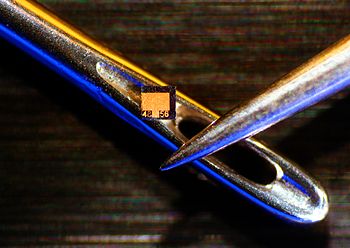Lasers: "The Conquest of Light" circa 1962 AT&T 9min - YouTube
 |
| Top: a packaged laser diode shown with a penny for scale. Bottom: the laser diode chip is removed from the above package and placed on the eye of a needle for scale. (Photo credit: Wikipedia) |
Lasers: "The Conquest of Light" circa 1962 AT&T 9min
http://youtu.be/xzlferSFFZI
"Tells the story of the laser, a device with unlimited potential in many areas, explaining how a laser works and what it is."
Public domain film from the Library of Congress Prelinger Archive, slightly cropped to remove uneven edges, with the aspect ratio corrected, and mild video noise reduction applied.
The soundtrack was also processed with volume normalization, noise reduction, clipping reduction, and equalization.
http://en.wikipedia.org/wiki/Laser
A laser is a device that emits light (electromagnetic radiation) through a process of optical amplification based on the stimulated emission of photons. The term "laser" originated as an acronym for Light Amplification by Stimulated Emission of Radiation. The emitted laser light is notable for its high degree of spatial and temporal coherence, unattainable using other technologies.
Spatial coherence typically is expressed through the output being a narrow beam which is diffraction-limited, often a so-called "pencil beam." Laser beams can be focused to very tiny spots, achieving a very high irradiance. Or they can be launched into a beam of very low divergence in order to concentrate their power at a large distance.
Temporal (or longitudinal) coherence implies a polarized wave at a single frequency whose phase is correlated over a relatively large distance (the coherence length) along the beam. A beam produced by a thermal or other incoherent light source has an instantaneous amplitude and phase which vary randomly with respect to time and position, and thus a very short coherence length.
Most so-called "single wavelength" lasers actually produce radiation in several modes having slightly different frequencies (wavelengths), often not in a single polarization. And although temporal coherence implies monochromaticity, there are even lasers that emit a broad spectrum of light, or emit different wavelengths of light simultaneously...
In 1953, Charles Hard Townes and graduate students James P. Gordon and Herbert J. Zeiger produced the first microwave amplifier, a device operating on similar principles to the laser, but amplifying microwave radiation rather than infrared or visible radiation...
In 1957, Charles Hard Townes and Arthur Leonard Schawlow, then at Bell Labs, began a serious study of the infrared laser. As ideas developed, they abandoned infrared radiation to instead concentrate upon visible light. The concept originally was called an "optical maser". In 1958, Bell Labs filed a patent application for their proposed optical maser...
Simultaneously, at Columbia University, graduate student Gordon Gould was working on a doctoral thesis about the energy levels of excited thallium. When Gould and Townes met, they spoke of radiation emission, as a general subject; afterwards, in November 1957, Gould noted his ideas for a "laser", including using an open resonator (later an essential laser-device component)...
At a conference in 1959, Gordon Gould published the term LASER in the paper The LASER, Light Amplification by Stimulated Emission of Radiation...
Gould's notes included possible applications for a laser, such as spectrometry, interferometry, radar, and nuclear fusion. He continued developing the idea, and filed a patent application in April 1959. The U.S. Patent Office denied his application, and awarded a patent to Bell Labs, in 1960. That provoked a twenty-eight-year lawsuit, featuring scientific prestige and money as the stakes. Gould won his first minor patent in 1977, yet it was not until 1987 that he won the first significant patent lawsuit victory, when a Federal judge ordered the U.S. Patent Office to issue patents to Gould for the optically pumped and the gas discharge laser devices...
On May 16, 1960, Theodore H. Maiman operated the first functioning laser, at Hughes Research Laboratories, Malibu, California, ahead of several research teams, including those of Townes, at Columbia University, Arthur Schawlow, at Bell Labs, and Gould, at the TRG (Technical Research Group) company. Maiman's functional laser used a solid-state flashlamp-pumped synthetic ruby crystal to produce red laser light, at 694 nanometres wavelength; however, the device only was capable of pulsed operation, because of its three-level pumping design scheme. Later in 1960, the Iranian physicist Ali Javan, and William R. Bennett, and Donald Herriott, constructed the first gas laser, using helium and neon that was capable of continuous operation in the infrared (U.S. Patent 3,149,290)... Basov and Javan proposed the semiconductor laser diode concept. In 1962, Robert N. Hall demonstrated the first laser diode device, made of gallium arsenide and emitted at 850 nm the near-infrared band of the spectrum. Later, in 1962, Nick Holonyak, Jr. demonstrated the first semiconductor laser with a visible emission...











Comments
Post a Comment